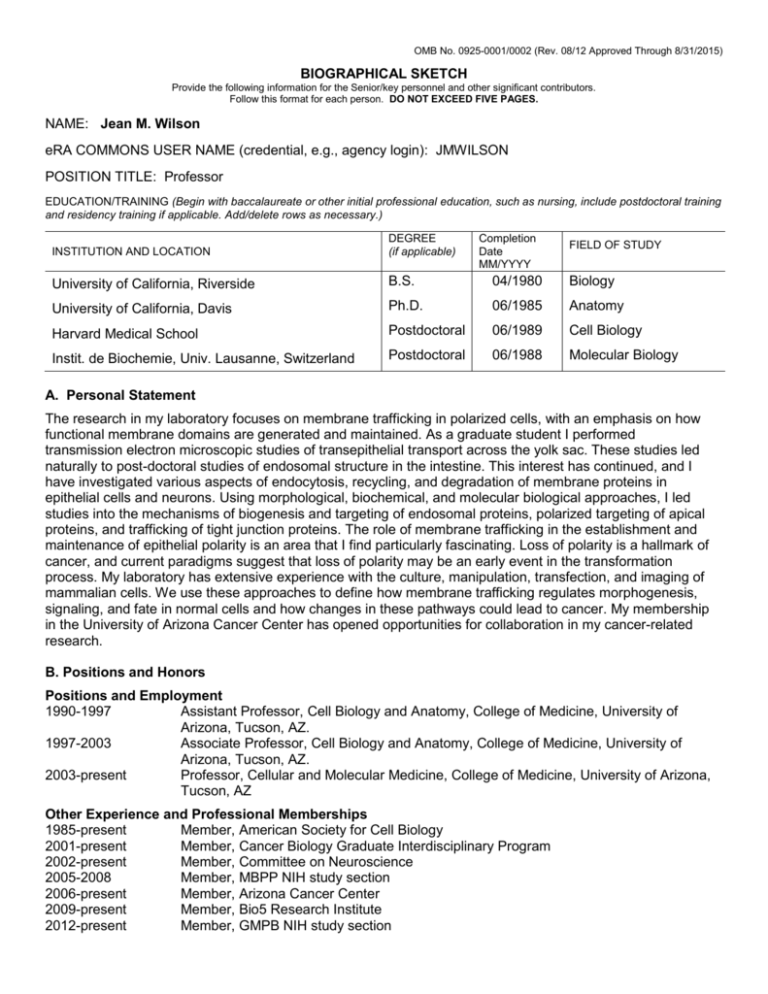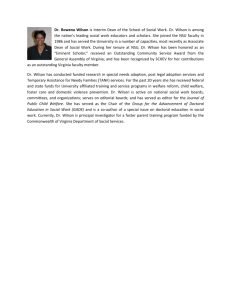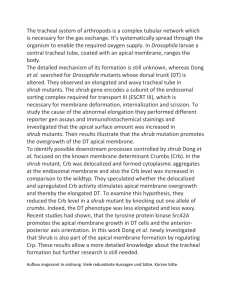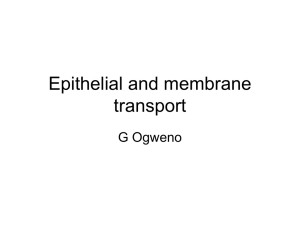OMB No. 0925-0046, Biographical Sketch Format Page
advertisement

OMB No. 0925-0001/0002 (Rev. 08/12 Approved Through 8/31/2015) BIOGRAPHICAL SKETCH Provide the following information for the Senior/key personnel and other significant contributors. Follow this format for each person. DO NOT EXCEED FIVE PAGES. NAME: Jean M. Wilson eRA COMMONS USER NAME (credential, e.g., agency login): JMWILSON POSITION TITLE: Professor EDUCATION/TRAINING (Begin with baccalaureate or other initial professional education, such as nursing, include postdoctoral training and residency training if applicable. Add/delete rows as necessary.) INSTITUTION AND LOCATION DEGREE (if applicable) Completion Date MM/YYYY University of California, Riverside B.S. 04/1980 Biology University of California, Davis Ph.D. 06/1985 Anatomy Harvard Medical School Postdoctoral 06/1989 Cell Biology Instit. de Biochemie, Univ. Lausanne, Switzerland Postdoctoral 06/1988 Molecular Biology FIELD OF STUDY A. Personal Statement The research in my laboratory focuses on membrane trafficking in polarized cells, with an emphasis on how functional membrane domains are generated and maintained. As a graduate student I performed transmission electron microscopic studies of transepithelial transport across the yolk sac. These studies led naturally to post-doctoral studies of endosomal structure in the intestine. This interest has continued, and I have investigated various aspects of endocytosis, recycling, and degradation of membrane proteins in epithelial cells and neurons. Using morphological, biochemical, and molecular biological approaches, I led studies into the mechanisms of biogenesis and targeting of endosomal proteins, polarized targeting of apical proteins, and trafficking of tight junction proteins. The role of membrane trafficking in the establishment and maintenance of epithelial polarity is an area that I find particularly fascinating. Loss of polarity is a hallmark of cancer, and current paradigms suggest that loss of polarity may be an early event in the transformation process. My laboratory has extensive experience with the culture, manipulation, transfection, and imaging of mammalian cells. We use these approaches to define how membrane trafficking regulates morphogenesis, signaling, and fate in normal cells and how changes in these pathways could lead to cancer. My membership in the University of Arizona Cancer Center has opened opportunities for collaboration in my cancer-related research. B. Positions and Honors Positions and Employment 1990-1997 Assistant Professor, Cell Biology and Anatomy, College of Medicine, University of Arizona, Tucson, AZ. 1997-2003 Associate Professor, Cell Biology and Anatomy, College of Medicine, University of Arizona, Tucson, AZ. 2003-present Professor, Cellular and Molecular Medicine, College of Medicine, University of Arizona, Tucson, AZ Other Experience and Professional Memberships 1985-present Member, American Society for Cell Biology 2001-present Member, Cancer Biology Graduate Interdisciplinary Program 2002-present Member, Committee on Neuroscience 2005-2008 Member, MBPP NIH study section 2006-present Member, Arizona Cancer Center 2009-present Member, Bio5 Research Institute 2012-present Member, GMPB NIH study section Honors 1999 2000 2014 University of Queensland Visiting Scholar Travel Award Furrow Award for Excellence in Graduate Education Teaching Outstanding Achievement in Teaching by a Block, Year II (Contributing faculty) C. Contributions to Science 1. Membrane Trafficking in the Intestine Our understanding of membrane trafficking pathways in epithelia was in its infancy when I began my postdoctoral studies. In particular, whether or not endosomes existed as stable structures in the cell or were merely transient intermediates was a matter of controversy. To address this, we isolated the apical endosomal compartment from developing rat intestine and generated monoclonal antibodies against these membranes. We identified Endotubin (EDTB) as an integral membrane protein that was resident in early endosomes. In later work, we showed that EDTB is targeted to a distinct endosomal compartment in both polarized and non-polarized cells, demonstrating that this specialized endosomal compartment exists in all cell types. This was one of the first demonstrations of endosomes as a stable organelle. In addition, we have now shown that endotubin has important roles in the regulation of tight junction integrity (described below). I was the primary researcher in the early studies of endotubin, and served as the Principal Investigator for the later studies. a. Wilson, J.M. , J.A. Whitney, and M.R. Neutra. 1987. Identification of an endosomal antigen specific to absorptive cells of suckling rat ileum. J. Cell Biol. 105:691-703. b. Speelman B.A., K.A. Allen, M.R. Neutra, T. Kirchhausen, and J.M Wilson. 1995. Molecular characterization of an early endosomal glycoprotein found in developing rat intestine. J. Biol. Chem. 270:1583-1588. c. Wilson, J.M. and T.L. Colton. 1997. Targeting of an intestinal apical endosomal protein to endosomes in non-polarized cells. J. Cell Biol. 136:319-330. d. Gokay, K.E. and J.M. Wilson. 2000. Targeting of an intestinal apical endosomal protein to apical endosomes in MDCK cells requires two sorting motifs. Traffic. 1:354-365. 2. Tight Junction Assembly, Regulation, and Control of Proliferation Tight junctions have historically been viewed as static, stable structures that control the paracellular movement of macromolecules and ions. However, recent work has shown that tight junctions undergo continuous remodeling and recycling. Our studies of the endosomal protein EDTB and Rab14 have led us to the discovery of the importance of endosomal regulation on tight junction assembly and signal transduction. We have shown that EDTB is required for normal junction assembly and that Rab14 is an essential regulator of junctional integrity through interaction with PKC. In addition, we discovered a surprising role for endotubin in contact-mediated inhibition of proliferation through interaction of endotubin with the tight junction protein angiomotin and downstream regulation of the oncoprotein YAP. These results have important implications for the role of membrane trafficking in the control of proliferation. I was the Principal Investigator for all of these studies. a. McCarter, S., D. Johnson, K.N. Kitt, C. Donohue, A.E. Adams and J.M. Wilson. 2010. Regulation of tight junction assembly and epithelial polarity by a resident protein of apical endosomes. Traffic 11:856-866 b. Lu, R., D.L. Johnson, L. Stewart, K. Waite, and J.M. Wilson. 2014. Rab14 regulates epithelial lumen morphogenesis through regulation of claudin-2 trafficking. Molec Biol Cell 25:1744-54 PMCID: PMC4038501 c. Lu,R, D. Dalgalan, E.K. Mandell, S.S. Parker, S. Ghosh and J.M. Wilson. 2015. PKC interacts with Rab14 and regulates epithelial barrier function through regulation of claudin-2 levels. Mol Biol Cell. 26(8):1523-31. doi: 10.1091/mbc.E14-12-1613. PMID:25694446 d. Cox, C.M., Mandell, E.K., Stewart, L., Lu, R., Johnson, D.L., McCarter, S.D., Tavares, A., Runyan, R., Ghosh, S., Wilson, J.M. 2015. Endosomal regulation of contact inhibition through the AMOT:YAP pathway. Mol Biol Cell 26:2673-84. doi: 10.1091/mbc.E15-04-0224 PMID:25995376 3. Cell Polarity A feature required for cells to carry out their specialized functions, be it epithelial cells, neurons, or migrating fibroblasts, is the ability to form specialized membrane domains, i.e. to polarize. In our studies of polarity, we found that small GTPase-mediated regulation of membrane trafficking and the cytoskeleton is essential for the development of polarized membrane domains. In addition, dynamic interactions of polarity complexes that are associated with tight junctions are also essential for the polarized phenotype. I was the Principal Investigator who directed the studies of small GTPases, and was a collaborator on the study of polarity complexes in neurons. a. Hernandez-Deviez, D., J.E. Casanova, and J. M. Wilson. 2002. Regulation of dendritic development by the ARF exchange factor ARNO. Nature Neurosci. 5:623-624. b. Hernandez-Deviez, D., J.E. Casanova, Roth, M.G., and J. M. Wilson. 2004. ARNO and ARF6 regulate axonal elongation and branching through phosphatidylinositol 4-phosphate 5-kinase a.Mol. Biol. Cell 15:111-21. c. Kitt, K.N., D. Hernandez-Deviez, S. McCarter, E. Spiliotis, J.E. Casanova, and J.M. Wilson. 2008. The small GTPase Rab 14 regulates apical targeting. Traffic 9:1218-1231 d. Parker, S.S., E.K. Mandell, S.M. Hapak, I.Y. Maskaykina,Y. Kusne, J.Y. Kim, J.K. Moy, P.A. St. John, J.M. Wilson, K.M. Gothard, T.J. Price, S. Ghosh. 2013. Competing interactions of PKMζ and aPKCλ with the Par complex regulates polarity. Proc Natl Acad Sci USA 110:14450-5. PMCID:PMC3761571 Complete List of Published Work in MyBibliography: http://www.ncbi.nlm.nih.gov/sites/myncbi/jean.wilson.1/bibliography/45925859/public/?sort=date&direction=a scending. D. Research Support Ongoing 5R01 DK084047-05 (Wilson, PI) 07/01/11-06/30/16 NIH/NIDDKD Regulation of Intestinal Tight Junction Structure by Membrane Traffic This funding provides support for our studies on the role of the endosomal protein endotubin and the small GTPase Rab14 in the establishment and maintenance of epithelial tight junctions. We are examining the role of polarized membrane traffic in tight junction integrity and how these events control epithelial permeability and barrier integrity.









